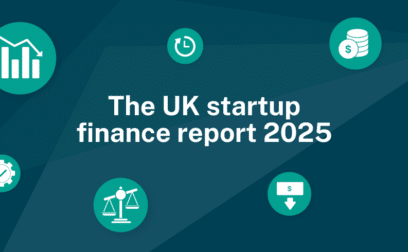TABLE OF CONTENTS
Page written by Chris Godfrey. Last reviewed on September 26, 2024. Next review due April 6, 2027.

Whether it’s due to post-pandemic struggles, Brexit effects, labour shortages, or even sky high energy bills, many UK SMEs will need to restructure in 2023. Restructuring can alleviate high debt, bring in new investment, close down under-performing business units or production lines, even save a business from insolvency. But what exactly is restructuring? How does it work? What are the benefits? And what kind of financial tools are involved? Read on to find out all you need to know about this important business strategy.
Business restructuring, also known as corporate restructuring, is the reorganisation of a company’s management, finances, and operations to improve the efficiency and effectiveness of the business. Restructuring is typically initiated to help an organisation increase its productivity, reduce costs, improve or change the products and services they sell, or to help a company better serve the needs of its customers and shareholders.
In some cases, a corporate restructuring may be initiated to help a business that has financial difficulties or is on the verge of insolvency. In cases like these, the business will usually restructure its debts and may sell off under-performing or non-essential assets.
Many businesses will conduct an informal restructuring during their existence, (outside the court system), although some may follow a legal corporate restructuring strategy as the result of a court judgement, or after filing for bankruptcy.
| Strategy | How it works |
|---|---|
| Organisational | To boost performance, management sell-off or close the business units or divisions that are under-performing or no longer fit the long-term goal. |
| Economic loss | Business units or special projects do not generate enough revenue to cover their capital expenditures, resulting in an economic loss. Management may choose to close, sell-off, or attempt to restructure the loss-inducing venture to make it profitable. |
| Reverse synergy | The corporation sells some of its assets when the value of a single business unit may be greater on its own than it will be by keeping it as part of the combined organisation. |
| Cashflow | The business sells an asset (loss-making or profitable) to raise cash and/or decrease debt when they are having difficulty securing financing. |
As well as providing a viable pathway out of debt and/or financial problems, organisations may achieve significant benefits from corporate restructuring:
Corporate restructuring may follow several different routes, each has their own strategy and goal:
Divestiture means selling a company’s non-core assets to another party. This usually involves an organisation selling off an unprofitable company, subsidiary, division, or other business unit rather than continue to invest it. This may be done to make the organisation more efficient and profitable by decreasing losses and maintaining a low debt-to-equity ratio, however it may also be done to avoid insolvency, or to raise emergency cash when other business loans are not forthcoming.
A joint venture is the creation of a new business entity between two or more companies. Each of the participating organisations agrees to provide specific resources and to split the costs, earnings, and control of the new business formed as a result of the collaboration. A joint venture makes good business sense when the new company will give the participants a more dominant role within their sector, opens new markets or launches a new type of product or service, or it brings together businesses with complimentary operations that will benefit more from a merger – such as a company with a new type of product joining forces with a company with an extensive distribution network.
A merger or acquisition is when another firm takes over an existing company, or a new company is formed by merging two or more existing companies. M&A transactions typically occur for the same reasons that joint ventures are made – although with mergers and acquisitions, one company usually absorbs the other and no new entity is formed. M&A transactions may also be conducted to eliminate market competition, or to capture a business innovation or rare resource. Businesses in financial trouble also commonly employ M&A transactions to avoid insolvency.
Reverse mergers allow private companies to become listed on the stock market without the necessity of an initial, and often unpredictable, public offering (IPO). In a reverse merger, a private firm acquires a controlling stake in an existing and publicly-traded company, gains control of the board of directors, and then merges all operations. This strategy can allow the private firm to become publicly traded very quickly and without the increased scrutiny of an IPO. Divestiture of some or all of the purchased company’s assets often follows a reverse merger, as the buying firm reshapes the operations of the newly combined business.
A spin-off involves a company separating a business unit, division, or even a product line, from the main organisation, and setting it up as a new stand-alone business. Spin-offs are often the target of a management buyout, where members of the main organisation’s leadership team see an opportunity in a portion of the combined business and offer to buy it out of the group and set up on their own. Spin-offs can provide useful cash for core organisations and, depending on the performance of the target business unit, can divest them of a venture that is not performing as well as desired. Sometimes, the main organisation may maintain a seat on the board of the spin-off, as well as playing a key role in their continued operation – such as with distribution.
A strategic partnership does not change the ownership of the participating businesses. Instead, they form an alliance, where the businesses may work together whilst still maintaining their own identities and line of operations. A strategic partnership is usually agreed to generate commercial synergies or exploit a resource or special opportunity. Some reshaping of each party’s operations may occur as they adjust to better fit the new partnership’s way of working.
Restructuring can be a tumultuous process as the internal and external structure of a company is adjusted and jobs are often cut. However, once completed, restructuring should result in a smoother, more economically sound business.
When a company restructures, the operations, processes, departments, or ownership may change. This may require severe changes to procedures, cause computer systems issues, fragment networks, change business locations, and create legal problems. Additionally, because positions may overlap or become obsolete, jobs may be eliminated, and employees laid off.
After the restructuring, the company may be in a stronger position to achieve its goals through greater efficiency in production, carrying less debt, streamlined distribution and offering better products and services.
Businesses that are in danger of falling into bankruptcy may be saved by conducting a corporate restructuring:
Businesses conduct a corporate restructuring for either operational or financial reasons, (sometimes both). Operationally, they are seeking to make the business more efficient and profitable. Financially, they wish to raise cash and decrease debt.
No matter if it’s for financial or operational needs, finance providers may offer funds as either loans or investment to support businesses during a restructuring:
Manage debt and cover restructuring costs
Businesses may restructure their current debts, and cover other restructuring costs by refinancing debts to achieve improved terms, securing new loans against company assets or their sales book, or taking on new investment. Common solutions include:
Business loans: Work like regular bank loans, may be secured or unsecured. Take out as new funding or to refinance existing debt.
Revolving credit facilities: An agreed credit pot that businesses may dip into as and when funds are needed. Pay off existing debt, cover merger expenses, joint ventures, and partnerships.
Asset finance and refinance: Pays for plant and machinery to help businesses operate more efficiently, or to free up the sunk capital in hard assets that the business already owns.
Commercial mortgages: Depending on the Loan To Value of the property, (LTV), borrow against your business premises. Use the funds to clear high-priced or overdue debt.
Development finance: Funds to pay for reconstruction, refurbishment and expansion of business premises. Get stalled projects working again. Add value to your asset book.
Equity finance: Pay off outstanding debt with new investment funds. Secure the cash you need in exchange for a share of ownership
Management buyout finance: Use to spin-off a company, division, business unit, or a brand.
Improve cashflow
Poor cashflow is the single biggest reason many SMEs fail. Improving cashflow can take the pressure off debt payments and help to maintain good relations with creditors. Common solutions include:
Invoice finance: Instead of waiting 30, 60, 90 days or more for payment, borrow against the value of your unpaid invoices and get paid as soon as the bills are raised.
Working capital loans: Sometimes, it’s the little things that cause big problems. Poor cashflow can leave organisations struggling to pay for basic needs such as energy, rent and wages. Working capital loans can cover everyday expenses, keep the lights on, keep your business trading.
Depending on the restructuring strategy, organisations may seek to consolidate production facilities, distribution networks, product lines, workforce resources, even the debts they carry. This will usually reduce overhead and provide the necessary cash to put the business on a solid footing. Consolidation is particularly common during M&A, reverse merger, and joint venture restructurings. Using a mix of the financial solutions shown above, consolidation finance may be used to:
Whether you’re seeking to restructure your business to gain greater financial security, or to move the organisation in a new direction, there are many financial options available to you. Register with Swoop to find the best restructuring finance. Give your business the fresh start it deserves.
Written by
Chris is a freelance copywriter and content creator. He has been active in the marketing, advertising, and publishing industries for more than twenty-five years. Writing for Barclays Bank, Metro Bank, Wells Fargo, ABN Amro, Quidco, Legal and General, Inshur Zego, AIG, Met Life, State Farm, Direct Line, insurers and pension funds, his words have appeared online and in print to inform, entertain and explain the complex world of consumer and business finance and insurance.
Swoop promise
At Swoop we want to make it easy for SMEs to understand the sometimes overwhelming world of business finance and insurance. Our goal is simple – to distill complex topics, unravel jargon, offer transparent and impartial information, and empower businesses to make smart financial decisions with confidence.
Find out more about Swoop’s editorial principles by reading our editorial policy.
Related pages
Get your free Business restructuring quote today
Join the 110,000+ businesses just like yours getting the Swoop newsletter.
Free. No spam. Opt out whenever you like.



























We work with world class partners to help us support businesses with finance
Kingfisher Way, Silverlink Business Park, Newcastle upon Tyne, NE28 9NX, UK
View in Google MapsAberystwyth Innovation and Enterprise Campus
Gogerddan Campus
Aberystwyth University
Ceredigion
SY23 3EE
Dogpatch Labs, The CHQ Building, Custom House Quay, Dublin, Ireland
View in Google MapsSuite 801, Level 8, 84 Pitt Street, Sydney, NSW 2000, Australia
View in Google Maps43 W 23rd St, New York, NY 10010, United States
View in Google Maps21 Dreyer Street, Cape Town, South Africa, 7708
View in Google Maps
Disclaimer: Swoop Finance helps UK firms access business finance, working directly with businesses and their trusted advisors. We are a credit broker and do not provide loans or other finance products ourselves. We can introduce you to a panel of lenders, equity funds and grant agencies. Whichever lender you choose we may receive commission from them (either a fixed fee of fixed % of the amount you receive) and different lenders pay different rates. For certain lenders, we do have influence over the interest rate, and this can impact the amount you pay under the agreement. All finance and quotes are subject to status and income. Applicants must be aged 18 and over and terms and conditions apply. Guarantees and Indemnities may be required. Swoop Finance can introduce applicants to a number of providers based on the applicants’ circumstances and creditworthiness. Swoop Finance Limited is registered with the Financial Conduct Authority as an Account Information Services Provider (reference number 833145). Swoop Finance Limited is authorised as a credit broker under FCA registration number 936513. If you feel you have a complaint, please read our complaints section highlighted above and also contained within our terms and conditions. Swoop Finance Ltd is registered with Companies House (company number 11163382, registered address The Stable Yard, Vicarage Road, Stony Stratford, Milton Keynes MK11 1BN). VAT number: 300080279
Clever finance tips and the latest news
Delivered to your inbox monthly
Join the 110,000+ businesses just like yours getting the Swoop newsletter. Free. No spam. Opt out whenever you like.
Thanks for requesting a call back
a member of the team will be in touch.




